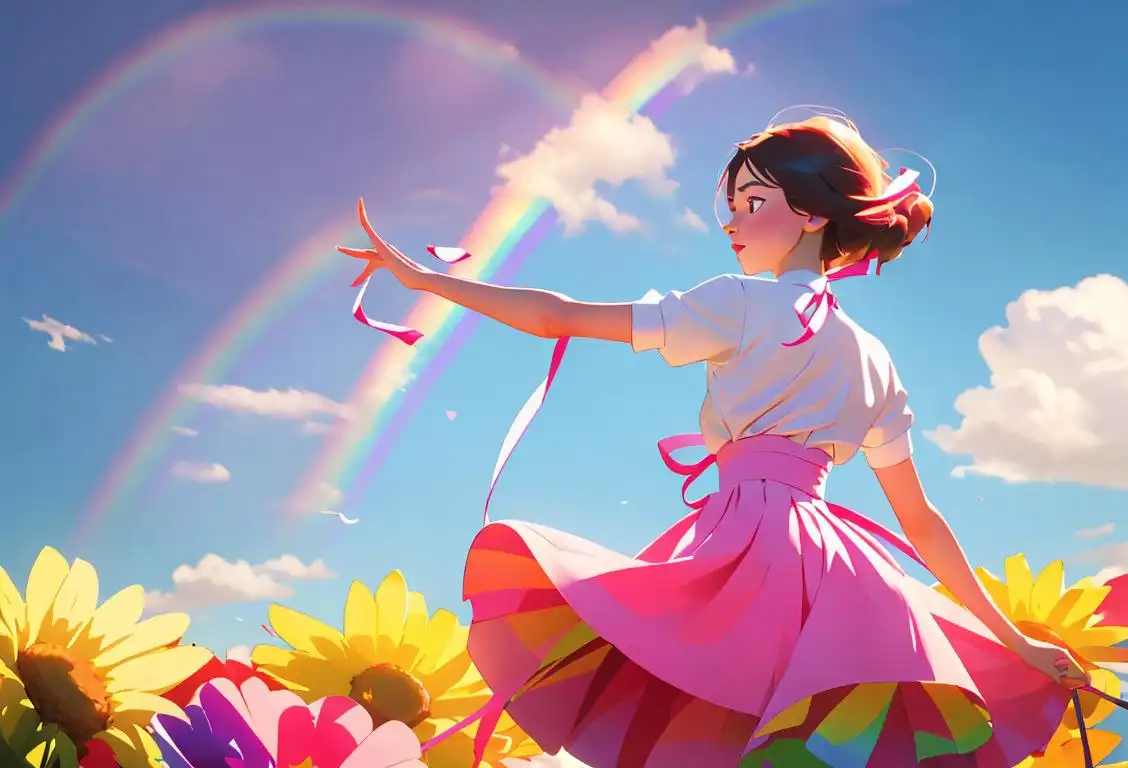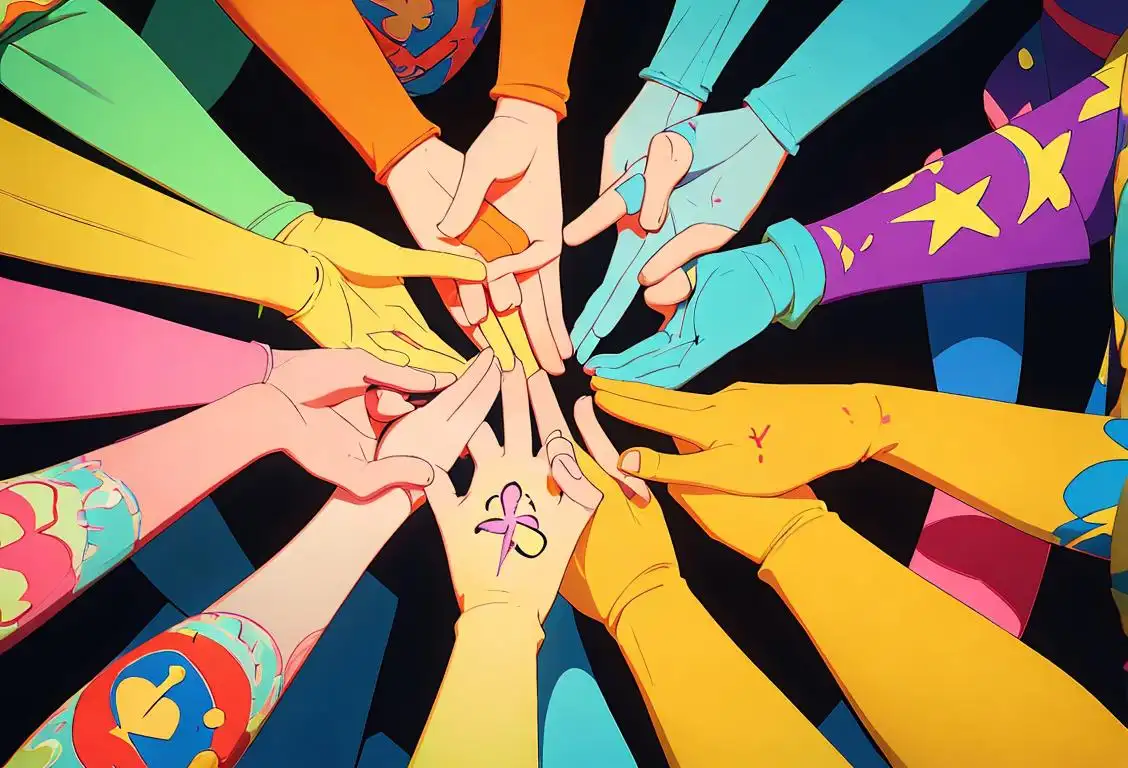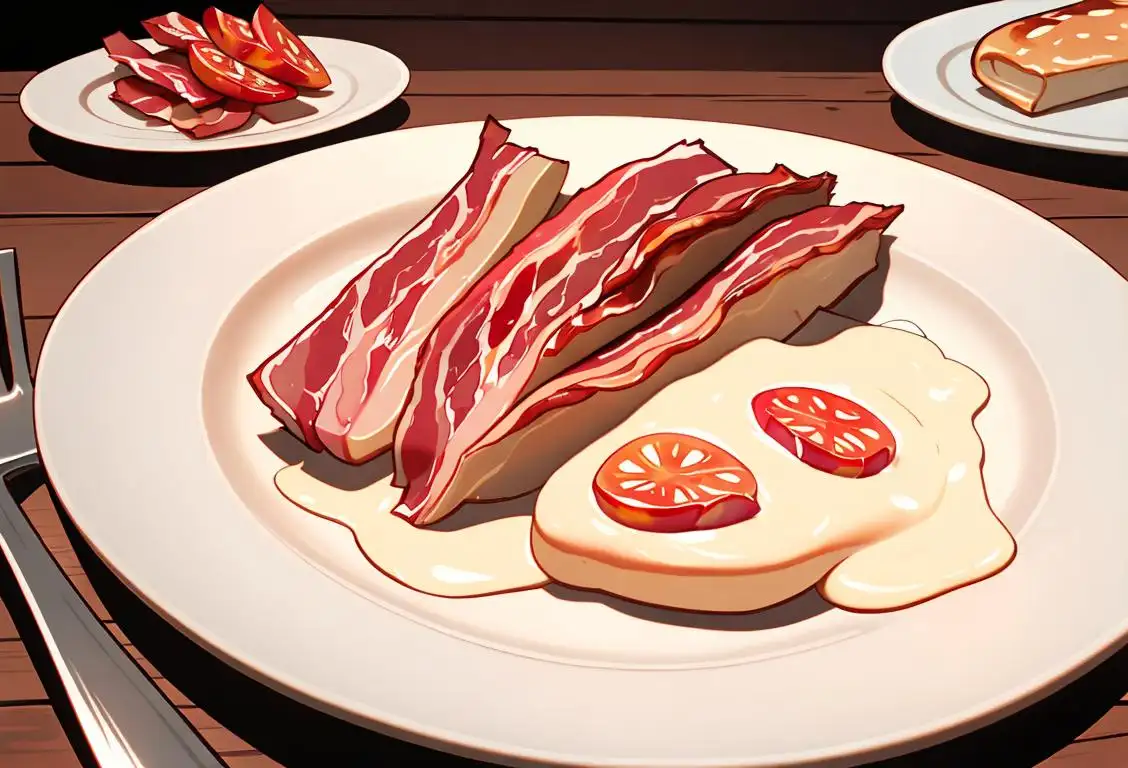National Ribbon Skirt Day

Welcome to the wonderful world of National Ribbon Skirt Day! Are you ready to dive into the rich history and delightful quirks of this special day? Well, hold on to your skirts (or pants, if that's more your style) because we're about to embark on an exciting journey!
When is Ribbon Skirt Day?
It's national ribbon skirt day on the 6th January.
The Origin of National Ribbon Skirt Day
Like a ribbon adorning a beautifully wrapped gift, National Ribbon Skirt Day adds a touch of elegance and cultural appreciation to our calendars. The roots of this day can be traced back to the rich Native American heritage and the significance of the ribbon skirt in their culture. The ribbon skirt, also known as the ribbon dress, is a traditional garment adorned with vibrant ribbons, representing unity, family, and cultural pride.
This special day serves as a way to honor and celebrate the artistry, craftsmanship, and deep cultural connections associated with ribbon skirts. It provides an opportunity to learn about the diverse native cultures that have embraced this graceful attire throughout history.
How to Celebrate National Ribbon Skirt Day
Celebrating National Ribbon Skirt Day is as easy as twirling in a circle. Here are a few fun ways to honor this special day:
- Rock a Ribbon Skirt: Don your own ribbon skirt and show off your style and solidarity with native cultures. Whether you sew one from scratch or purchase one from a talented artisan, wearing a ribbon skirt will make you feel like a floating work of art!
- Support Native Artists: Show your love and appreciation for the craftsmanship and talent behind ribbon skirts by supporting local native artisans. Shop for ribbon skirts, accessories, and other traditional crafts to add a touch of cultural beauty to your life.
- Learn and Educate: Take the time to learn more about the history and significance of ribbon skirts in Native American cultures. Explore the symbolism of the ribbons, the patterns used, and the stories that are woven into each design. Share your newfound knowledge with friends and loved ones.
Did You Know?
Did you know that ribbon skirts have been a part of Native American traditions for centuries? They have evolved and adapted over time, reflecting the diverse cultures and artistic expressions of native communities. From powwows to special ceremonies, ribbon skirts continue to be cherished and celebrated as a symbol of cultural heritage. So, the next time you see someone rocking a ribbon skirt, remember that it's not just a piece of clothing, but a vibrant representation of history, craftsmanship, and unity!
History behind the term 'Ribbon Skirt'
1900
The Introduction of Ribbon Skirts
In the early 1900s, ribbon skirts emerged as a culturally significant garment within Native American communities. These skirts were traditionally made by Indigenous women and featured vibrant ribbons sewn onto a fabric base, often displaying intricate patterns and symbols that held deep cultural meaning.
Past centuries
Origins of the Ribbon Skirt
The Ribbon Skirt has its roots in many Indigenous cultures, particularly in North America. It has been worn by Indigenous women for generations and holds significant cultural and symbolic meaning. The original Ribbon Skirts were handcrafted using traditional methods and materials.
1800s
The Origins of Skirts
In the 1800s, skirts were widely worn by women as a part of their daily attire. These skirts were typically long, flowing garments that reached the ankle. They were often made of various fabrics and were considered an essential element of women's fashion at the time.
1800s
Introduction of the term
During the 1800s, the term 'ribbon skirt' was first used to describe a specific style of skirt worn by Indigenous women in North America. These skirts were typically made of wool or cotton fabric and featured vibrant ribbons sewn onto the hem. The ribbons were an important element in the design, often chosen for their symbolic meaning and cultural significance.
19th Century
Introduction of Traditionally Styled Skirts
In the 19th century, Native American women often wore skirts as part of their traditional attire. These skirts were usually made from animal skins or woven fabric and featured various patterns and designs that held cultural significance.
1800s
Introduction of the skirt
The ribbon skirt originated in the 1800s among the Indigenous tribes of North America. It was primarily worn by Native American women as a symbol of cultural identity and pride. The skirt featured a simple design with vertical stripes of brightly colored ribbons sewn onto a fabric base. This traditional garment played a significant role in the cultural practices and ceremonies of Indigenous communities.
19th century
Introduction of the skirt
In the 19th century, the ribbon skirt made its first appearance. This traditional garment has deep cultural significance for many Indigenous communities across North America. The skirt is typically made of a rectangle-shaped fabric that is worn around the waist and falls to the ankles. The name 'ribbon skirt' comes from the colorful ribbons that are often sewn onto the fabric in vibrant patterns.
1800s
Introduction of Ribbons
During the 1800s, ribbons became more accessible and affordable. Indigenous women started incorporating ribbons into their skirts, adding vibrant colors and intricate patterns. These ribbons enhanced the beauty and cultural significance of the skirts.
1960s
Revival and Adaptation
During the 1960s, there was a resurgence of interest in Native American culture and traditions. This led to a revival of the ribbon skirt as a symbol of identity and cultural expression. Native American women began adapting the traditional design to incorporate personal stories, tribal motifs, and contemporary elements.
Late 19th Century
Incorporation of Ribbons in Skirt Designs
As Western influence began to permeate Native American communities, women started incorporating ribbons into their skirt designs. This addition added a vibrant and decorative element to the traditional skirts, enhancing their overall beauty and visual appeal.
Late 19th Century
The Emergence of Ribbon Skirts
During the late 19th century, Native American women began to incorporate ribbons into their traditional skirts. The introduction of ribbons added beautiful and vibrant patterns to the garments, enhancing their visual appeal. This innovative twist on the conventional skirts sparked the creation of what would later become known as the 'ribbon skirt.'
Colonial era
Influence of European fabrics
During the colonial era, Indigenous communities were exposed to European fabrics and designs through trade and colonization. This led to the incorporation of new materials like calico, wool, and cotton into the traditional ribbon skirts. The introduction of these fabrics brought new colors and patterns to the skirts, enriching the visual appeal and symbolism of this cultural attire.
Early 1900s
Evolution of design
In the early 1900s, the design of ribbon skirts began to evolve. Native American women incorporated their own creative touches by incorporating traditional beadwork and embroidery into the skirts. This added intricacy and beauty to the garment, making it a symbol of cultural identity and artistic expression.
Late 19th century
Expansion of design
During the late 19th century, the ribbon skirt saw an expansion in its design. Indigenous women began experimenting with various colors, patterns, and ribbon placements. This led to a greater diversity in the appearance of the skirt, as different tribes incorporated their distinctive artistic styles and symbols onto the garment. The skirt became not just a piece of clothing but also a canvas for cultural expression and storytelling.
Late 19th to Early 20th Century
Colonial Influence and Cultural Restriction
With the colonization and assimilation efforts, Indigenous cultures faced oppression and cultural restrictions. Many Indigenous people were forced to abandon their traditional attire and adopt Western clothing. However, some Indigenous women continued to preserve their cultural identity by wearing Ribbon Skirts in secret or modified forms.
20th century
Revitalization of Indigenous culture
In the 20th century, there was a growing movement to reclaim and revitalize Indigenous cultures and traditions. This resurgence included a renewed emphasis on traditional clothing, including the ribbon skirt. Indigenous artists, designers, and activists worked to preserve and promote the importance of ribbon skirts as a form of cultural expression and resistance against assimilation. The skirts became an important symbol of identity, representing pride in Indigenous heritage.
20th Century
Symbol of Cultural Identity
In the 20th century, the ribbon skirt became more than just a fashionable garment. It gained significance as a symbol of cultural identity and resurgence for Native American communities. By wearing ribbon skirts, women proudly showcased their heritage and celebrated their cultural roots. The skirts represented a connection to ancestral traditions and served as a visual representation of Native American history and pride.
1978
The Indian Arts and Crafts Act
In 1978, the Indian Arts and Crafts Act was passed in the United States to protect Native American artisans and their creations. This legislation helped regulate the sale and labeling of Indigenous artwork, including ribbon skirts. It aimed to prevent non-Indigenous individuals from falsely claiming their products as authentic Native American pieces, thus protecting the cultural integrity of ribbon skirts and other traditional crafts.
20th century
Suppression and resurgence
In the early 20th century, as a result of colonization and assimilation policies, Native American culture and traditional garments like the ribbon skirt faced suppression. Indigenous people were often forced to abandon their cultural practices and adopt Western clothing styles. However, during the latter half of the century, there was a resurgence of pride in Indigenous identity and reclaiming of cultural traditions. The ribbon skirt regained popularity among Native American communities as a symbol of resilience and cultural revitalization.
Mid-20th century
Symbol of resistance
By the mid-20th century, ribbon skirts had taken on a new role as a symbol of resistance and cultural preservation. Indigenous communities across North America embraced the ribbon skirt as a way to assert their heritage and resilience in the face of colonialism. Wearing a ribbon skirt became an act of pride and a statement of identity.
Mid-20th Century
Evolution into the Ribbon Skirt
By the mid-20th century, the skirt style featuring ribbons had evolved into what is now known as the 'ribbon skirt.' This term became associated with skirts that prominently featured colorful ribbons sewn near the hemline. The ribbons were arranged in patterns that held personal or cultural significance for the wearer.
1970s
Revival and Empowerment
In the 1970s, there was a notable resurgence of interest in Native American culture and heritage. This revival not only sparked a renewed appreciation for traditional arts and crafts but also empowered Native American communities to reclaim their cultural practices. The ribbon skirt played a significant role in this movement, as it symbolized resilience, strength, and a celebration of Native American womanhood.
1970s
Symbol of Cultural Identity and Resistance
During the 1970s, ribbon skirts gained even more significance within Native American communities. They became an emblem of cultural identity and a symbol of resistance against the suppression of indigenous cultures. Many Native American women wore ribbon skirts during political rallies, cultural events, and ceremonies to express their pride in their heritage and assert their resilience.
Mid-20th Century
Revitalization and Pan-Indian Movement
In the mid-20th century, there was a resurgence of Indigenous pride and cultural revitalization. Ribbon Skirts became a symbol of resistance and cultural resilience. The Pan-Indian movement, which aimed to unite Indigenous peoples across different tribes and regions, embraced the Ribbon Skirt as a unifying garment.
21st century
Wider recognition and contemporary adaptations
In the 21st century, the ribbon skirt has gained wider recognition and appreciation outside Indigenous communities. It has become a symbol of cultural diversity, inclusivity, and respect. Many non-Indigenous individuals have embraced the ribbon skirt as a way to show solidarity and support for Indigenous rights and traditions. Moreover, contemporary adaptations of the ribbon skirt have emerged, blending traditional designs with modern fashion trends, creating a fusion of cultural heritage and contemporary style.
Contemporary times
Empowering women's voices
In contemporary times, the ribbon skirt has become a powerful symbol of Indigenous women's resilience, strength, and activism. It is often worn during cultural ceremonies, powwows, and social gatherings, making a bold and beautiful statement. Ribbon skirts have also gained recognition beyond Indigenous communities, transcending cultural boundaries and becoming a popular fashion statement. They are now celebrated as a way to honor and appreciate Indigenous artistry, craftsmanship, and cultural heritage.
1990s
Contemporary Fashion and Empowerment
By the 1990s, ribbon skirts had transcended their traditional boundaries and started gaining recognition in the mainstream fashion industry. Designers and artists began incorporating ribbon skirts into their collections, showcasing the beauty and cultural significance of this Indigenous garment. This newfound visibility helped empower Native American communities and shed light on the richness of their cultural heritage.
Contemporary times
Continued significance
The ribbon skirt continues to hold deep cultural significance in Indigenous communities today. It is worn for various occasions, including powwows, ceremonies, and social gatherings. Many Indigenous designers have also reimagined the traditional ribbon skirt, combining traditional techniques with modern fashion influences, creating stunning designs that bridge the past and the present.
Present Day
Continued Significance and Revival
Today, the ribbon skirt continues to be an important piece of cultural attire among Native American women. It is not only worn for special occasions but also embraced as an everyday fashion statement. The revival of ribbon skirts has also led to an increased appreciation for Native American craftsmanship and traditional designs, fostering cultural preservation and revitalization.
Present Day
Empowerment and Cultural Expression
The Ribbon Skirt continues to be worn by Indigenous women as a symbol of empowerment, cultural expression, and reclaiming their heritage. It is often showcased during powwows, ceremonies, and other cultural events. The designs on Ribbon Skirts carry personal and cultural meanings, representing tribal affiliations, family histories, and spiritual connections.
Present Day
Symbol of Resilience and Cultural Pride
Today, ribbon skirts continue to be worn by Indigenous women as a symbol of resilience, cultural pride, and connection to their heritage. These skirts have become an important form of self-expression and a way to reclaim and celebrate Native American identity. They are often worn on special occasions, powwows, and ceremonies, serving as a visible reminder of the strength and beauty of Indigenous cultures.
Present Day
Continued Cultural Significance
Today, the ribbon skirt continues to hold cultural significance in Native American communities. It is worn during powwows, ceremonies, and cultural events as a way to honor and preserve Native American traditions. Moreover, the ribbon skirt has transcended its cultural boundaries and become a symbol of unity and diversity. It serves as a reminder of the rich cultural tapestry of Native American heritage and a celebration of their enduring legacy.
Did you know?
Did you know that ribbon skirts have been a part of Native American traditions for centuries?Tagged
awareness fun loved onesFirst identified
6th January 2021Most mentioned on
6th January 2021Total mentions
102Other days
Compliment Day
Cheese Pizza Day
Pumpkin Day
Medal Of Honor Day
Guac Day
Foundation Day
Suicide Prevention Day
Memorial Day
Cancer Survivors Day
Bacon Day









